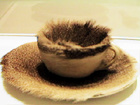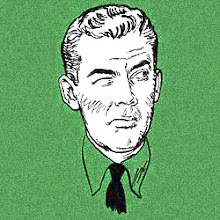Jasper Johns, Painting with Two Balls (1960). Encaustic and collage on canvas with object. I saw this at the Philadelphia Museum of Art when the painting was on loan from the artist's collection.
Monday, May 25, 2015
Tuesday, May 5, 2015
Tuesday, April 7, 2015
fascism not confined to the Twilight Zone
Rod Serling's antifascist closing narration to the March 4, 1960, episode of "The Twilight Zone"—"The Monsters Are Due on Maple Street." http://bit.ly/1a2tS7z (audio)
Monday, March 9, 2015
Whitman, Williams, Oppen
George Oppen in a letter to William Carlos Williams, Summer 1960: "People who are afraid to talk won't produce much poetry. Tho Whitman has been no use to me. Perhaps arriving after you I don't need him. I always feel that that deluge and soup of words is a screen for the uncertainty of his own identity." (Selected Letters of George Oppen, ed. Rachel Blau DuPlessis, p. 39)
Sunday, March 1, 2015
the conservative's selection of Ez
Conservative publisher Henry Regnery put out a book of miscellaneous (and in some cases uncollected) essays on American civilization by Ezra Pound.
Wednesday, February 18, 2015
Jasper Johns, "Flashlight"
Jasper Johns, Flashlight (1960); cast 1980-81. Made of bronze and glass. (Philadelphia Museum of Art, February 2015, on loan from a collection of the artist.)
Thursday, February 12, 2015
Saturday, February 7, 2015
Hannah Weinstein's "The Four Just Men"
Hannah Weinstein, living and working in England since 1952 to avoid anticommunist blacklisting and possible congressional prosecution in the U.S., created a British television series aired in 39 episodes in late 1959 and 1960 called The Four Just Men. Someone has done us the favor of making 37 of the episodes available on YouTube here. One episode features the resurgence of fascism by way of a weekly magazine that has caused fights between the "Americans" and Puerto Ricans in a boys' club. Below is a screenshot of what Mr. Rivera, father of a boy who is stabbed in a scuffle with "Americans," reads in Garnes Weekly.
Thursday, February 5, 2015
Wednesday, January 28, 2015
Nam June Paik cuts off John Cage's tie
On October 6, 1960, at Mary Bauermeister's atelier in Cologne, while performing Etude for Pianoforte, shy young Nam June Paik suddenly and violently took a scissors and cut off John Cage's tie as Cage was sitting near the front of the audience.
Subscribe to:
Comments (Atom)











 Is '60 the moment when the end of the end of the Old Left had been reached and the New Left began to emerge? Is it the final ascendancy, in certain scenes at least, of poetic postmodernity? Surely the publication of Donald Allen's The New American Poetry that year suggests this, but then again--once again--we look back on "New" here and see continuity. The rhetoric of the Kennedy-Nixon contest made much less of a dent than everyone (at the time as well as since) claimed, so one wonders why were such great claims made?
Is '60 the moment when the end of the end of the Old Left had been reached and the New Left began to emerge? Is it the final ascendancy, in certain scenes at least, of poetic postmodernity? Surely the publication of Donald Allen's The New American Poetry that year suggests this, but then again--once again--we look back on "New" here and see continuity. The rhetoric of the Kennedy-Nixon contest made much less of a dent than everyone (at the time as well as since) claimed, so one wonders why were such great claims made?  Had we come to expect "1960" to be truly ubiquitously modern in a way that the 1950s really were not--not quite? And what specifically does "modern" mean in the Kennedyesque talk then and now about the torch being passed to a new generation, etc.? The First Lady really meant "modernist" when Camelotians said "modern." What about the others across the new young cultural leadership? I've been surprised by how frequently the
Had we come to expect "1960" to be truly ubiquitously modern in a way that the 1950s really were not--not quite? And what specifically does "modern" mean in the Kennedyesque talk then and now about the torch being passed to a new generation, etc.? The First Lady really meant "modernist" when Camelotians said "modern." What about the others across the new young cultural leadership? I've been surprised by how frequently the  "Beat movement" was covered in 1960 in the mainstream press. I was expecting a fair measure but I've found tonnage. 1960 was the year when the figure of the beat was beginning to find acceptance, although still 80% of these stories are mocking, rebels-without-cause condescension. For anyone whose analysis made an impact nationally, do these antipolitical adolescents count as part of the "new young cultural leadership"? No, but rather than the two being opposites, they fall along a Continuum of the New American. Now that's a change for '60.
"Beat movement" was covered in 1960 in the mainstream press. I was expecting a fair measure but I've found tonnage. 1960 was the year when the figure of the beat was beginning to find acceptance, although still 80% of these stories are mocking, rebels-without-cause condescension. For anyone whose analysis made an impact nationally, do these antipolitical adolescents count as part of the "new young cultural leadership"? No, but rather than the two being opposites, they fall along a Continuum of the New American. Now that's a change for '60.







